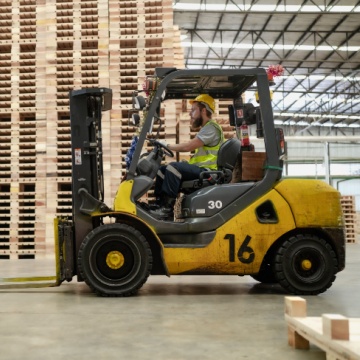Whether in a construction site, warehouse, or any other industrial premise, forklifts are amongst the most commonly used equipment. These heavy-duty industrial trucks are capable of bearing heavy loads and are used extensively for lifting and transportation. However, if forklifts are not used appropriately, they can cause serious workplace accidents. According to the latest statistics, forklift accidents account for almost 25% of all construction-related accidents. Also, experts suggest that 70% of these accidents can be avoided just by implementing adequate accident prevention solutions and conducting operator training.
How to Prevent Different Types of Forklift Accidents
There are many different types of forklift accidents such as forklift overturns, falling loads, pedestrians getting hit by the forklift, falls from forks, etc. In many instances, these mishaps are the result of mechanical failures, blocked sight, and lack of employee training.
Forklift Tipovers and Rollovers:
These are some of the most serious forklift accidents that may even lead to fatalities. A rollover accident occurs when a forklift falls onto its sides. On the other hand, a tip-over takes place when the front portion of the forklift tips forward. In these cases, forklift operators run the risk of getting thrown off and crushed under the forklift. People working in areas adjacent to the forklifts may also sustain severe injuries. Forklifts tend to roll over or tip over because of harsh turnings, overspeeding, exceeding the load limit, or driving over uneven or inclined surfaces.
These accidents can be avoided by
- Not exceeding the standard speed limit.
- Decreasing the speed significantly while taking turns.
- Not exceeding the recommended weight capacity of the forklift.
- Operating on a smooth surface, whenever possible.
- Providing training to forklift operators.
- Investing in technology-enabled forklift safety solutions.
Pedestrian Accidents:
Anyone working in the vicinity of forklifts is also vulnerable to accidents. In the worst case scenario, they may get hit or even run over by a forklift. Injuries may also result from heavy objects falling off a forklift. These accidents take place mostly because of a lack of visibility and clear warning signs. Operator inattention is also a contributing factor. A large majority of these accidents can be avoided by adhering to proper forklift driving safety measures.
- Pedestrians should always keep a safe distance from operating forklifts.
- Use of proper uniforms to ensure clear visibility.
- Indication of forklift zones using floor tapes.
- Use of barriers and different coloured lights to separate pedestrian walkways from forklift traffic.
- Use of accident prevention systems such as alarms or sensors.
- Ensure ongoing training for forklift operators and pedestrians.
Falling Loads:
This is another common concern with forklifts that involves objects falling, tipping, or sliding off the forks of a forklift. These accidents can be attributed to moving the loads unsecured or placing them loose or off-centre. Deformed/bent forks or lack of load backrest can also result in these accidents.
Please follow these simple tips to avoid mishaps resulting from falling loads.
- All loads must be secured before transporting them.
- Avoid carrying loose or damaged materials.
- Place the heaviest loads near the forklift’s front wheels.
- Be extremely careful while tilting the mast.
- Use load backrests.
- Carry out pre-trip inspections using technology-based forklift safety solutions.
To sum up, forklift accidents can be reduced drastically by following proper safety practices, providing training to employees, and utilising modern accident prevention solutions. At ShockWatch, we have a comprehensive range of solutions designed specifically to address the vulnerabilities of forklift operations. Please contact our technicians today to find out more.


